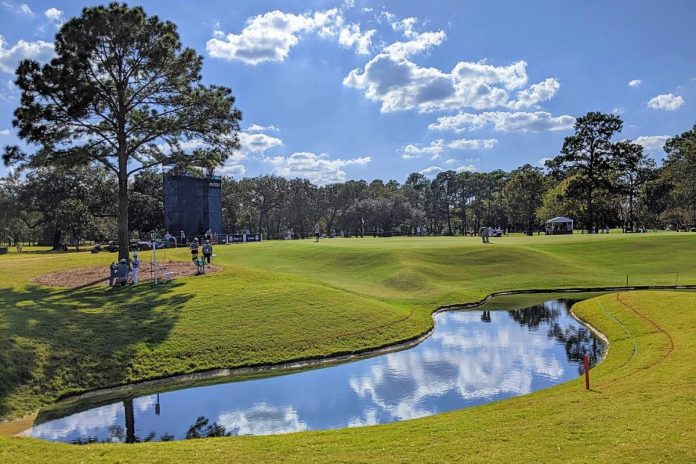The PGA Tour schedule often includes courses with difficult par 3s of 200 yards or more that test the skills of the best players in the world.
As competition courses change, course planners have to make adjustments for how strong professional players are getting. To keep the course challenging, tee boxes are often pushed further back.
But when planner Tom Doak went to work on fixing up Memorial Park, he wanted to do things differently. He put a lot of focus on shorter holes, especially par 3s.
The 15th Hole: A Short, Yet Treacherous Test
When the PGA Tour comes to Memorial Park, the 15th hole is the one that gets the most attention. For pros, this hole may look like a simple choice since it is just under 160 yards long for competition play.
However, it is anything but easy. The 15th hole has become a strategic focal point for both players and planners because it is in a great spot to possibly decide the results of the Houston Open.
Doak consulted with major champion Brooks Koepka during the course’s redesign, and Koepka’s advice focused heavily on ensuring variety among the par 3s.
He made it clear that the goal wasn’t just to make every hole 210 yards long. The 15th was made because of this request. It is shorter than the 14th, but it has a much harder job than it seems at first.
A Course With Strategic Variety
It looks like the 15th hole at Memorial Park is a simple, short par 3, but it is actually very dangerous. Along the left side of the hole, there is a creek that always serves as a warning that any shot that goes off could lead to a penalty.
On top of that, massive slopes on both sides of the green make approach shots particularly challenging, leaving little room for error. Even the best players have to be very precise and careful when making shots around these dangers.
Doak said that this was done on purpose to make things different from the usual long, hard par 3s that you see on a lot of PGA Tour courses. “Yes, hole 15 is very dangerous.”
“It’s one of those,” Doak said, adding that Koepka wanted a variety of shorter holes, which is why this difficult hole was made. “Especially that one, it’s the shortest one and it’s the nastiest one.”
Read Also: Encrypted Apps Amid Cyberattack
Memorable Moments at 15: Birdies, Bogeys, and Beyond
In the first two rounds of the Houston Open’s debut at Memorial Park, the 15th hole did its fair share of damage to the field, but also provided plenty of birdies.
On the first day of play in 2020, the hole was playing as short as 110 yards, and despite its short length, it produced 35 birdies with a front-right pin placement.
However, players who missed the green were faced with a much harder task. A total of 15 players made bogey on the hole, and 11 more saw their scorecard stained with a double bogey.
As the tournament progressed, with the pin placements moved further back in subsequent rounds, the severity of the hole was dialed down a bit. Even so, the hole stayed a source of stress, with lots of drama and scores that changed all the time.
As the last round got closer, a lot of people thought the pin would be hidden in a more dangerous spot, maybe in the front left corner, where the creek and hills would be even more of a problem.
The hole’s design and placement were integral to the drama unfolding during the tournament, and it was clear that the 15th would play a decisive role.
Doak’s Hope for the Hole’s Legacy
Looking ahead, Doak hopes that the 15th hole will become one of the most memorable and iconic challenges of the week—not for a mishap, but for a moment of brilliance.
“I hope the most famous hole of the week is for something somebody does that’s great,” Doak said. What this means is that the builder wanted the hole to be known as a place that rewarded skill and strategy rather than just punishing mistakes.
Read More: Kamal Aroush
Memorial Park is getting more well-known, and the 15th hole will soon be one of the hardest on the course. It will be exciting and heartbreaking for both players and fans.
It’s a hole that shows how important smart shot-making is and how random professional golf is. For years to come, No. 15 will always be an important part of the Houston Open, whether it’s in the final round or in the early rounds.



















